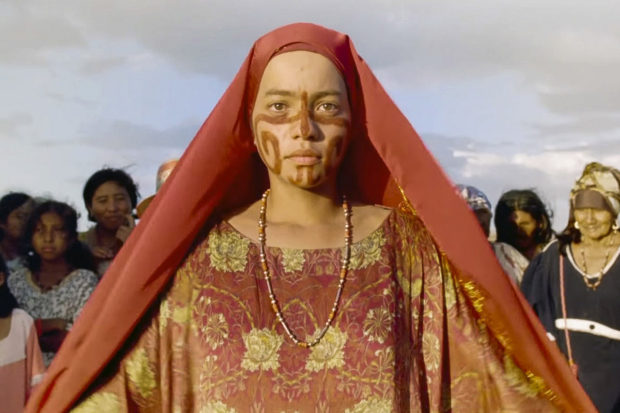
 A remarkable film from Colombia depicts how a traditional Indian tribe is corrupted by wealth and power through its involvement in the drug trade.
A remarkable film from Colombia depicts how a traditional Indian tribe is corrupted by wealth and power through its involvement in the drug trade.
Birds of Passage, a remarkable new film from Colombia, combines some very different things into one. It’s a crime picture about the drug trade in South America, but it’s also steeped in indigenous culture, particularly that of the Wayuu Indians of northeastern Colombia. This melding of the ancient and strangely beautiful native traditions with a tale, based on true events, of violent hatred and revenge, is more powerful and frightening than most gang movies you’ll encounter.
The film is directed by Cristina Gallego and Cirro Gerra, the producer and director of 2015’s breakout sensation Embrace of the Serpent, a story of a shaman and the fatal influence of European explorers on the Amazon region. It was one of my favorite films of that year. Here they’ve changed direction. That film, shot in black and white, was focused on a more distant past, the early 20th century—Birds of Passage, in brilliant color, covers the late 1960s through the early 80s, although in its style and tone it often evokes a timeless feeling of fate and eternity.
The story begins with a young man named Rapayet, played by José Acosta, orphaned and thus without much influence in the complex Wayuu tribal structure. He has managed to make connections with the alijunas, a word for Spanish-speaking Colombians, outsiders who can help him make money. In 1969 he witnesses the coming-out day of Zaida, played by Natalia Reyes. Coming-out day is a ceremony in which the beautiful girl is transformed in the eyes of her village into a marriageable young woman. She’s the daughter of this village’s clan leader, Úrsula, played by Carmiňa Martínez, guardian of the village’s ritual spirit object. Her daughter Zaida has prophetic dreams which the mother interprets. This powerful woman is the person Rapayet must please if he wants to marry Zaida. She demands a very expensive dowry—dozens of goats and cows, along with some rare necklaces, fully expecting that he won’t be able to succeed. But he comes up with a scheme to have an older cousin convert his coffee farm into a marijuana farm, and with the help of his best friend Moisés, an alijuna, is able to connect his product with American dealers. Rapayet marries Zaida, and the clan becomes wealthy. But money goes to Moisés’s head. With the heedless arrogance of an outsider, he starts killing people, and little by little the family and the tribe are drawn into revenge killings and eventually all-out war.
The first conclusion one might draw from this is that the Western influence—the illegal drug trade with its high stakes and capitalist dog-eat-dog philosophy—has corroded traditional native society. And that is true. But the film is also interested in other things. The strongest elements of the Wayuu culture—absolute loyalty to family and clan, honor above all, and inflexible adherence to ancient tradition—are especially vulnerable to the corruption of great wealth and power. None of the grown-ups in this story are innocent. They participate in their own self-destruction because power and dominance are integral parts of their social mores. Combine that with the toxic effect of non-Indian cultural elements, including, significantly, alcohol, and you have a tragedy of titanic proportions.
The entire complex, many-faceted tale—there are lots of characters that I haven’t had time to mention—is executed with a wildly baroque visual style. As the family becomes wealthier, their clothes and possessions begin to seem surreal. Their beautiful modernist stucco mansion exists in the middle of a barren landscape, exemplifying the grotesque nature of their supposed success. Yet in the midst of all this horror, Gallego and Gerra continue to remind us of a lost bond with the earth, with shots of symbolic insects and birds, including the migrating ones of the title. Birds of Passage is an eerily beautiful portrait of the seeds of self-destruction that lie within us.

